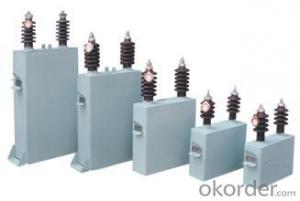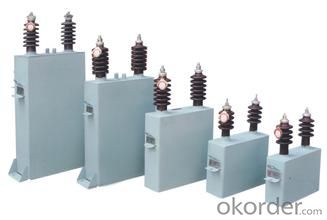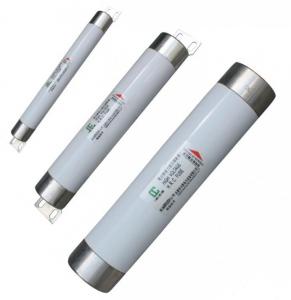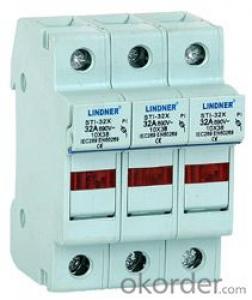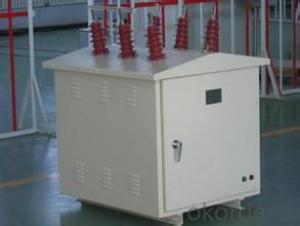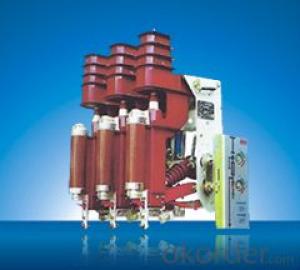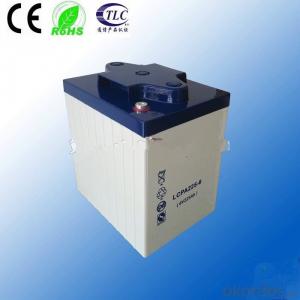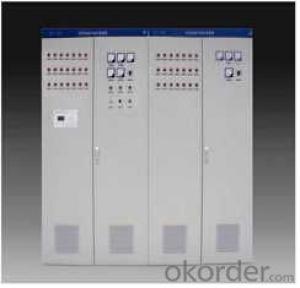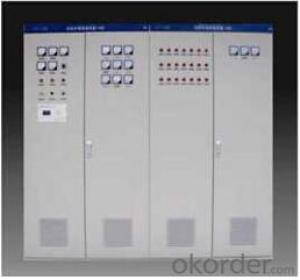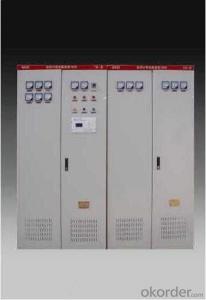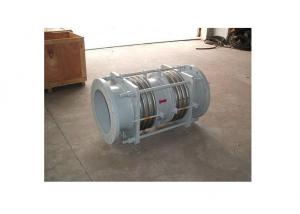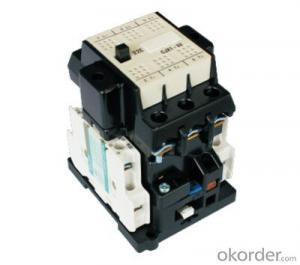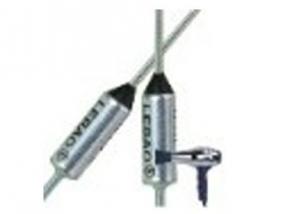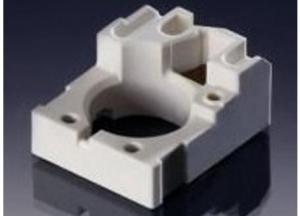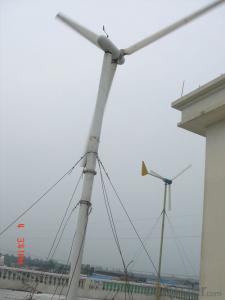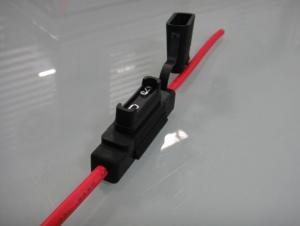JKL607 Series Reactive Automatic Power Compensation Controller
- Loading Port:
- China Main Port
- Payment Terms:
- TT OR LC
- Min Order Qty:
- -
- Supply Capability:
- -
OKorder Service Pledge
OKorder Financial Service
You Might Also Like
| Applications |
JKL607 series reactive automatic power compensation controller is designed according to the latest National standards of JB/T9663-1999,which is to be used together with low voltage electrostatic capacitance screen of various specifications,to provide real-time supervision on the power factor and reactive current of the power network,and give automatic throw-cut capacitor compensation to the power network. |
| Structure Characteristics |
1. No throw-cut vibration,precise control within the range of full loads. |
| Code and Its Meanings |
| Operation Conditions |
1. Altitude:≤2000m |
| Main Technical Parameters |
1. Rated Voltage:jkl607A/B/C 380V JKL607FA/FS 220V |
| Installation Size |
The installation of JKL607 series adopts inserted case,with installation hole on the side.Put the hook of the fastening accessory into the hole,tighten the screw of the accessory and the controller is fixed on the scree. |
- Q: i drive a 1997 buick lasabre and i just replaced the taillights. the brake lights light up, but the tail lights dont, whats wrong? im not a car mechanic so i could really use some help. the bulb is a double filament.
- Check your fuse box. It could be you are not getting power from your dash switch to the lights.
- Q: I'm doing some wiring and I do not quite understand the difference between AC12v and DC12v. I need an item to run on DC12v, Can I simply clip the wires on my object that needs DC12v and connect the appropriate ends to the appropriate battery terminals?Please do not answer (12v) ^^ Thanks!
- Yes well in a car it is higher that that while it is running but it will work for your purposes there is around 12 VDC at the positive terminal with respect to the negative terminal or car ground if that terminal is wired to the car or engine. You can wire directly if you are a brave soul but for safety you might want to put a fuse in the positive line before connecting it to the battery in case a short develops. The fuse size would just be over the amperage requirement for the device you are powering. If you are not sure start with a 1 amp fuse and work your way up in size if it blows if it doesn't then it should do the trick and protect some minimal protection if things go wrong.
- Q: I had the fuse break on a Joker 200 light, but I don't know what could cause a surge of electricity (no lightning storm at the time). If it matters, it could have been on the same line as a coffee maker/toaster/microwave. Please help me out. Thanks!
- The main component in the ballast is a large inductor, and if a turn gets shorted, it will draw high current. Suspect the ballast. Also, with a coffee maker and a microwave, the total current could be too high for the circuit breaker.
- Q: Help me please. My son installed a battery into his 99 ford escort. However he attached neg to pos and pos to neg. Can this fry out the alternator. Or could it simply be something electrical. There was a wire left off, going to somewhere. And a black wire coming from the internal fuse box.
- The alternator and other components might be fried also, have a mechanic check everything
- Q: i checked the fuses, i had similar problems when i tried to install a stereo deck myself. Also my srs lights are on and my window does not open.
- time for another car friend. don't mess with this as it is old. face it jap cars don't last forever. u no n japan they don't rebuild anything? everything is replaced every 100,000 km which is 66000 miles. ur car isn't designed to last. that is why every jap car in a wreck is totalled. the jap car co's make more money selling u a new car. so but another jap car. I don't want to catch u riding n a real car, like a 57 chevy or 67 mustang. I will pop u n tha haid an take it from ya.
- Q: I have a 2000 Chevy Tahoe 5.3L. The front AC works fine, it blows nice cold air. The rear AC does not work. When I turn either of the overhead ac control swicth on, I can hear a click in the rear passenger pannel but no air comes out at all. I checked the fuse box under the hood and the HVAC fuse was blown (30A). I replaced that and turned the rear ac back on. Again, I hear a click in the rear panel. I can hear that everytime I turn either switch on each controller on and off. Went to check the fuse and was blown again, but I can still hear the clicking sound in the rear even with the fuse blown. I believe there are 3 components in the rear ac system. 1) Hot/Cold Actuator 2) Floor/Ceiling Actuator and 3) Control Module. Now, is one of these bad? Where is my problem? I don't want to start replacing parts without knowing what is really bad on my vehicle.Please help. Thanks
- Should be in the blower itself, not the actuators. What you can do is get a short finder so you dont have to keep replacing 30A fuses, but unplug the relay in the back for the blower motor see if the short is before the rear HVac or inside the rear HVAC. If it doesnt blow then insert the relay unplug the blower itself see if it is the problem. Maybe it or a short in the wiring somewhere
- Q: hello i have a short in my car the keeps blowing my ingnition relay fuse and i cant find it. no matter how hard i search. have any of u used one of that short circuit finds like this page describes Tech and if u did is it hard to use and how do you use it? i dont wanna spend $50 on junk.
- An induction short finder shouldn't cost $50 around for a less expensive alternative. These work very well in locating the shorted circuit and generally will pretty much pinpoint the area where the circuit is actually shorted.
- Q: How to calculate the value of a FUSE which is to be employed in a circuit by wire's resistance and load resistancei read somewhere that 8g of wire needs 50 amp fuse and 14g needs 10 amp,so my question here in second part is how does we relate wieght of wire to the amps of fusekindly proceed for a answerthnx
- weight of a wire has nothing to do with the fuse size. After all, the same weight could describe a very long thin wire that could only handle a low current, or a short thick wire that could handle a lot more current. You can look up the wire's current capability in wire tables. Or consult your local wire codes, for house wiring. For example, AWG 14 wire should be fused for 15 amps, AWG 12 for 20 amps. If the fuse is to protect the wire, size it via the wire tables. But often the fuse is to protect electronic components, and it that case, other rules apply. .
- Q: E.C.M. stands for electronic control modal
- Checking fuses is fine - probing the electronic module wires with a test light can easily short out an internal component.
- Q: Battery is Good, Alternator is good, both have been tested. My car starts up with no problem. when im driving in a neighborhood without having to apply alot of pressure on the gas everything is fine. But the moment i enter a freeway/highway where i have to press the gas a little harder my alternator fuse (30a) blows instantly as soons i begin to speed up the battery light comes on. I put another fuse in and same thing, everything is fine when im not pressing the gas hard but the moment i have to apply pressure my alternator fuse blows and the Battery comes on. So replcaed the fuse once again. This time i put some tape around my O2 Sensor wires. And wala! It worked, no fuse blowing when i speed up but then after like 15 min of driving it started back :/. What could be a possible fix?? thanks!!
- Alternator Fuse Keeps Blowing
Send your message to us
JKL607 Series Reactive Automatic Power Compensation Controller
- Loading Port:
- China Main Port
- Payment Terms:
- TT OR LC
- Min Order Qty:
- -
- Supply Capability:
- -
OKorder Service Pledge
OKorder Financial Service
Similar products
Hot products
Hot Searches
Related keywords
